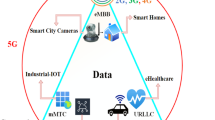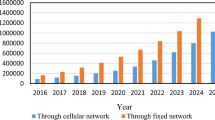Abstract
This research article presents an innovative approach based on analog network coding (ANC) in conjunction with space time block coding (STBC) which is termed as space time analog network coding (STANC). The STANC investigated as an affective network coding strategy to combat the effects of shadowing and path loss in wireless networks. The another objective of this research work is to evaluate the impact of relay location on system performance in increasing shadowing effect due to increasing tall structure like multistory building in metropolitan area. The performance of the proposed system is analyzed in terms of symbol error rate (SER), STANC gain and ergodic capacity using analytical expressions. Moment generating function approach is used to drive the SER for M-PSK modulated signals. The approximate closed-form expression of ergodic capacity is presented using the derived mean and second moment for STANC based cooperative system. Rician shadowed model is used which efficiently evaluate the effect of shadowing as compared to other fading models given in the literature which is the main advantage of this model. Numerical results signify that the approximated analytical expressions derived can be effectively used for performance improvement under path loss and shadowing effect as compared to simple ANC based system.




Similar content being viewed by others
References
Ahlswede, R., Cai, N., Li, S.-Y., & Yeung, R. (2000). Network information flow. IEEE Transactions on Information Theory, 46(4), 1204–1216.
Wang, S., Venkateswaran, V., & Zhang, X. (2017). Fundamental analysis of full-duplex gains in wireless networks. IEEE/ACM Networks Transactions, 25, 1401–1416.
Yu, Q., Zhang, D., Chen, H., & Meng, W. (2016). Physical-layer network coding systems with MFSK modulation. IEEE Transactions on Vehicular Technology, 65, 204–213.
Cheng, Y., & Yang, L. (2013). Joint relay ordering and linear finite field network coding for multiple-source multiple-relay wireless sensor networks. International Journal of Distributed Sensor Networks, 9(10), 729–869.
Maric, I., Goldsmith, A., & Medard, M. (2007). Information-theoretic relaying for multicast in wireless networks. In IEEE Military Communications Conference (pp. 1–7).
Liu, Y., Zhang, W., & Ching, P. C. (2016). Time-reversal space–time codes in asynchronous two-way relay networks. IEEE Transactions on Wireless Communications, 15(3), 1729–1741.
Rankoy, B., & Wittneben, A. (2007). Spectral efficient protocols for half-duplex fading relay channels. IEEE Journal of Selected Areas in Communications, 25(2), 379–389.
Zheng, L., Xia, X.-G., & Li, B. (2009). Achieving full diversity and fast ML decoding via simple analog network coding for asynchronous two-way relay networks. IEEE Transactions on Communications, 57(12), 3672–3681.
Wei, L., & Chen, W. (2013). Space–time analog network coding for multiple access relay channels. In IEEE Wireless Communications and Networking Conference (pp. 2961–2965).
Agrawal, R. (2005). Performance of routing strategy (bit error based) in fading environments for mobile adhoc networks. In IEEE International Conference on Personal Wireless Communications (pp. 550–554).
Loo, C. (1985). A statistical model for a land mobile satellite link. IEEE Transactions on Vehicular Technology, 34, 122–127.
Abdi, A., Lau, W. C., Alouini, M. S., & Kaveh, M. (2003). A new simple model for land mobile-satellite channels: First and second order statistics. IEEE Transaction on Wireless Communications., 2(3), 519–528.
Uysal, M., & Georghiades, C. N. (2004). Effect of shadowing on the performance of space–time trellis coded systems. IEEE Transactions on Wireless Communications, 3(4), 1037–1042.
Uysal, M., & Georghiades, C. N. (2004). Upper bounds on the BER performance of MTCM-STBC schemes over shadowed Rician fading channels. EURASIP Journal on Advances in Signal Processing, 9, 904563.
Uysal, M., & Georghiades, C. N. (2004). Upper bounds on the BER performance of MTCM-STBC schemes over shadowed Rician fading channels. EURASIP Journal on Applied Signal Processing, 9, 1238–1245.
Ropokis, G. A., Rontogiannis, A. A., Berberidis, K., & Mathiopoulos, P. T. (2009). Performance analysis of maximal ratio combining over shadowed Rician fading channels. In International Workshop on Satellite and Space Communications (pp. 83–87).
Zang, G., & Li, G. (2006). Performance analysis of orthogonal space–time block codes over shadowed Rician fading channels. In Information Theory Workshop (pp. 453–457).
Li, Z., Fu, X., Wang, S., Ti, P., & Jie, L. (2018). Achievable rate maximization for cognitive hybrid satellite-terrestrial networks with AF-relays. IEEE Journal on Selected Areas in Communications, 36(2), 304–313.
Ikki, S., & Ahmed, M. H. (2008). Performance analysis of incremental relaying cooperative diversity networks over Rayleigh fading channels. In IEEE Wireless Communications and Networking Conference (pp. 1311–1315).
Kumar, N., & Bhatia, V. (2015). Performance analysis of amplify-and-forward cooperative networks with best-relay selection over Weibull fading channels. Wireless Personal Communications, 85, 641–653.
Gradshteyn, I. S., & Ryzhik, I. M. (2007). Table of integrals, series and products (7th ed., p. 341). New York: Academic Press.
Gacanin, H., & Adachi, F. (2010). Broadband analog network coding. IEEE Transaction on wireless communication, 9(5), 1577–1583.
Proakis, J. (2001). Digital communications (4th ed.). New York: McGraw-Hill.
Men, J., Ge, J., & Zhang, C. (2016). Performance analysis of nonorthogonal multiple access for relaying networks over Nakagami-m fading channels. IEEE Transactions on Vehicular Technology, 66(2), 1200–1208.
Chen, S., Wang, W., & Zhang, X. (2009). Ergodic and outage capacity analysis of cooperative diversity systems under Rayleigh fading channels. In IEEE International Conference on Communications Workshops (pp. 1–5).
Author information
Authors and Affiliations
Corresponding author
Additional information
Publisher's Note
Springer Nature remains neutral with regard to jurisdictional claims in published maps and institutional affiliations.
Rights and permissions
About this article
Cite this article
Tanoli, S.A.K., Mustafa, A., Nawaz, F. et al. SER and throughput analysis of space–time analog network coded relaying system over shadowed Rician fading channels. Wireless Netw 25, 5045–5056 (2019). https://doi.org/10.1007/s11276-019-02110-7
Published:
Issue Date:
DOI: https://doi.org/10.1007/s11276-019-02110-7




